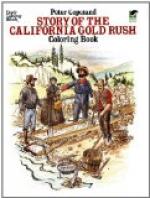[Illustration: LEAPING TUNA.]
[Illustration: BLACK SEA BASS.]
Late that night the steamer got to San Pedro, and you may be sure Tom and Retta were up early the next morning. As they came off the boat, there was a crowd of people on the wharf who were pulling in “yellow-tail” as fast as they dropped their lines. This fine fish is a little like a big salmon, but with golden-yellow fins and tail. Its body is greenish gray, with spots of the prettiest rainbow colors, which grow brighter as the fish dies. These fish bite easily, but as soon as caught begin to rush back and forth, fighting and trying to snap the line.
The children here took a smaller steamer for the twenty-mile trip across to Catalina Island, and on the way over they saw a whole “school” of whales and a flight of flying-fishes. Yes, really and truly, these little fish fly or sail through the air, for their fins balance them like a parachute. They skim along ten or twelve feet above the waves, and then drop in the water to rest, taking another flight whenever their enemies, the porpoises, chase them.
How happy the children were to land at the little town of Avalon, and to know that they were to have a month at this beautiful place! They hurried down to the beach and their first choice of amusements was the glass-bottomed boat. These boats have “water-telescopes,” which are only clear glass set in boxed-in places. The glass seems to make the ripples still, so that you can look down, down to the bottom of the ocean, twenty or thirty feet below you.
The boatman rowed the children out in the bay, where the water, now green, now blue, was always clear as crystal. On the rocks and sand at the bottom starfish and crabs crawled slowly along or clung to some stone. The purple sea-urchins, queer round-shelled creatures covered with thorny spines, crowded together, and the ugly toad-fish hid in the green and brown seaweeds. Blue, purple, and rainbow-colored jellyfish floated on top of the waters, while gold perch with red and green sunfish swam through the seaweed “like parrots in some hot country’s woods,” Retta thought. In the shallow places on the rocks those curious sea-flowers, the anemones, looked like pink or green cactus blossoms. The children never tired of the water-telescope in all their stay at the island.
At night the warm ocean waters seemed on fire, since they are full of very tiny, soft-bodied creatures, each of which gives out a faint, glowing light. Every day the fishermen brought in new and strange fishes. The black sea-bass, heavier than the fisherman himself and longer than he was tall, were wonderful, and they could hardly believe that such big fish were caught with a rod and line.




